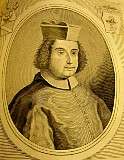Giacomo Cantelmo
Giacomo Cantelmo (13 June, 1645 – 11 December, 1702) was a Roman Catholic cardinal from 1690 to 1702.[1]

Biography
Giacomo Cantelmo was born in Naples on June 13, 1645, the son of Fabrizio Cantelmo, 5th Duke of Popoli and prince of Pettorano, and Beatrice Brancia, duchess of Padula.[1] The family's surname is sometimes given as Cantelmo-Stuart because they were related to James II of England. Restaino Cantelmo-Stuart was his younger brother.
Prior to attending university, Cantelmo had mastered Latin, Greek, and Hebrew. He was educated at the Sapienza University of Rome and at the University of Bologna.[1]
Pope Innocent XI named him abbot in commendam of San Antonio di Vienna in Naples. On June 4, 1678, he was named inquisitor of Malta. He served as Referendary of the Apostolic Signatura.[1]
On September 27, 1683, he was elected Titular Archbishop of Caesarea. He was consecrated as a bishop by Cardinal Carlo Pio di Savoia, Titular Bishop of Sabina, on October 3, 1683. He became nuncio to Vienna in 1683. He then served as nuncio to Switzerland from April 18, 1685 to December 10, 1687. On October 23, 1688, he was named nuncio extraordinary to Poland. He became nuncio extraordinary to Austria on October 25, 1689. He then returned to Rome to become secretary of the Sacred Congregation for Bishops and Regulars.[1]
On February 23, 1690, he was named extraordinary nuncio to the imperial election held at Augsburg and which elected Joseph of Austria as King of the Romans.[1]
In the consistory held on February 13, 1690, Pope Alexander VIII created him a cardinal priest. On April 10, 1690, he attended Joseph's coronation as King of the Romans; on the same day, he received the red hat, was awarded the titular church of Santi Marcellino e Pietro al Laterano, and named papal legate to Urbino. He was transferred to the metropolitan see of Capua on September 27, 1690, receiving the pallium on December 11, 1690.[1]
He participated in the papal conclave of 1691, which elected Pope Innocent XII. The new pope transferred him to the metropolitan see of Naples, with Cantelmo receiving the pallium on August 8, 1691. There, he held a diocesan synod on Pentecost 1694. He also convened a provincial synod, attended by 13 bishops, and opened on June 7, 1699.[1]
He participated in the papal conclave of 1700, which elected Pope Clement XI. The new pope named him Camerlengo of the Sacred College of Cardinals, with Cantelmo serving from February 3, 1700 to January 23, 1702.[1]
He died in Naples on December 11, 1702.[1]
References
- Miranda, Salvador. "CANTELMO, Giacomo (1645-1702)". The Cardinals of the Holy Roman Church. Florida International University. Retrieved 5 August 2018.
| Catholic Church titles | ||
|---|---|---|
| Preceded by Savo Millini |
Titular Archbishop of Caesarea in Cappadocia 1683–1690 |
Succeeded by Lorenzo Casoni |
| Preceded by Odoardo Cibo |
Apostolic Nuncio to Switzerland 1685–1687 |
Succeeded by Bartolomeo Menatti |
| Preceded by Opizio Pallavicini |
Apostolic Nuncio to Poland 1687–1689 |
Succeeded by Francesco Giambattista Bonesana |
| Preceded by Francesco Buonvisi |
Apostolic Nuncio to Emperor 1689 |
Succeeded by Sebastiano Antonio Tanara |
| Preceded by |
Secretary of the Congregation of Bishops and Regulars 1689 |
Succeeded by |
| Preceded by Girolamo Boncompagni |
Cardinal-Priest of Santi Marcellino e Pietro 1690–1702 |
Succeeded by Francesco Pignatelli (seniore) |
| Preceded by Gasparo Cavalieri |
Archbishop of Capua 1690–1691 |
Succeeded by Giuseppe Bologna |
| Preceded by Antonio Pignatelli del Rastrello |
Archbishop of Naples 1691–1702 |
Succeeded by Giambattista Patrizi |
| Preceded by Bandino Panciatici |
Camerlengo of the Sacred College of Cardinals 1700—1702 |
Succeeded by Toussaint de Forbin-Janson |